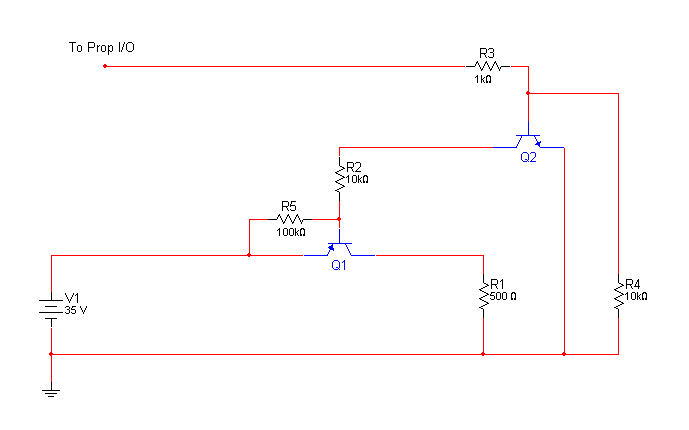Prop High(er) voltage interface
This is problem a simple and unsophisticated solution, but I need to control the flow of current from a solar panel to a load. The current will be under PWM control from the propeller, but I'm afraid of a bad wiring design and frying the prop. I would use a P-mosfet, but don't want to wait for the order. I have a TON of some high-freq, 7A, 80V PNP transistors that I've found to have a pretty low Vce saturation voltage. Pulling 600mA through it, I only get a 0.125V drop. Anyway, I'm trying to use these transistors to control the current, but I'm afraid of some kind of voltage spike or something frying a pin. Oh, the PNP is a 2SA2023, and the NPN is a 2N3904.
Any problems/suggestions?
Oh, a basic electrical question... If I want to move 1 coulomb through a 100 ohm resistor, won't it take more energy to move it the faster it goes? i.e. current rate of 1A for 1 second, vs. 2A for 1/2 second?
1A*1A*100ohms*1second = 100 Joules
2A*2A*100ohms*0.5seconds = 200 Joules?
The reason I ask, is I'm thinking that if I'm using PWM to control current flow, then higher current and lower duty cycle would have higher losses, right?
Any problems/suggestions?
Oh, a basic electrical question... If I want to move 1 coulomb through a 100 ohm resistor, won't it take more energy to move it the faster it goes? i.e. current rate of 1A for 1 second, vs. 2A for 1/2 second?
1A*1A*100ohms*1second = 100 Joules
2A*2A*100ohms*0.5seconds = 200 Joules?
The reason I ask, is I'm thinking that if I'm using PWM to control current flow, then higher current and lower duty cycle would have higher losses, right?
pdf

42K



Comments
But what is this 100ohms?
Graham
Think of it another way. In order to double the current through that resistor, you have to double the voltage (V=IR). So to move the coulomb in half the time, you need twice the voltage and twice the current which equals four times the power (P=VI).
Bottom line: Haste makes waste
▔▔▔▔▔▔▔▔▔▔▔▔▔▔▔▔▔▔▔▔▔▔▔▔
Post Edited (Ken Peterson) : 6/28/2008 2:57:12 AM GMT
What type of load do you have? Is it purely resistive as your diagram shows?
▔▔▔▔▔▔▔▔▔▔▔▔▔▔▔▔▔▔▔▔▔▔▔▔
Add a small cap in parallel to R3 (say .01uf). This will speed up the switching time.
▔▔▔▔▔▔▔▔▔▔▔▔▔▔▔▔▔▔▔▔▔▔▔▔
I = C dv/dt
with that capacitance, you can charge the cap to 3.3V at 40ma in 1 microsecond.
▔▔▔▔▔▔▔▔▔▔▔▔▔▔▔▔▔▔▔▔▔▔▔▔
Post Edited (Ken Peterson) : 6/28/2008 4:12:14 AM GMT
I would use an opto-isolator for sure. They are pretty
slow but very in-expensive.